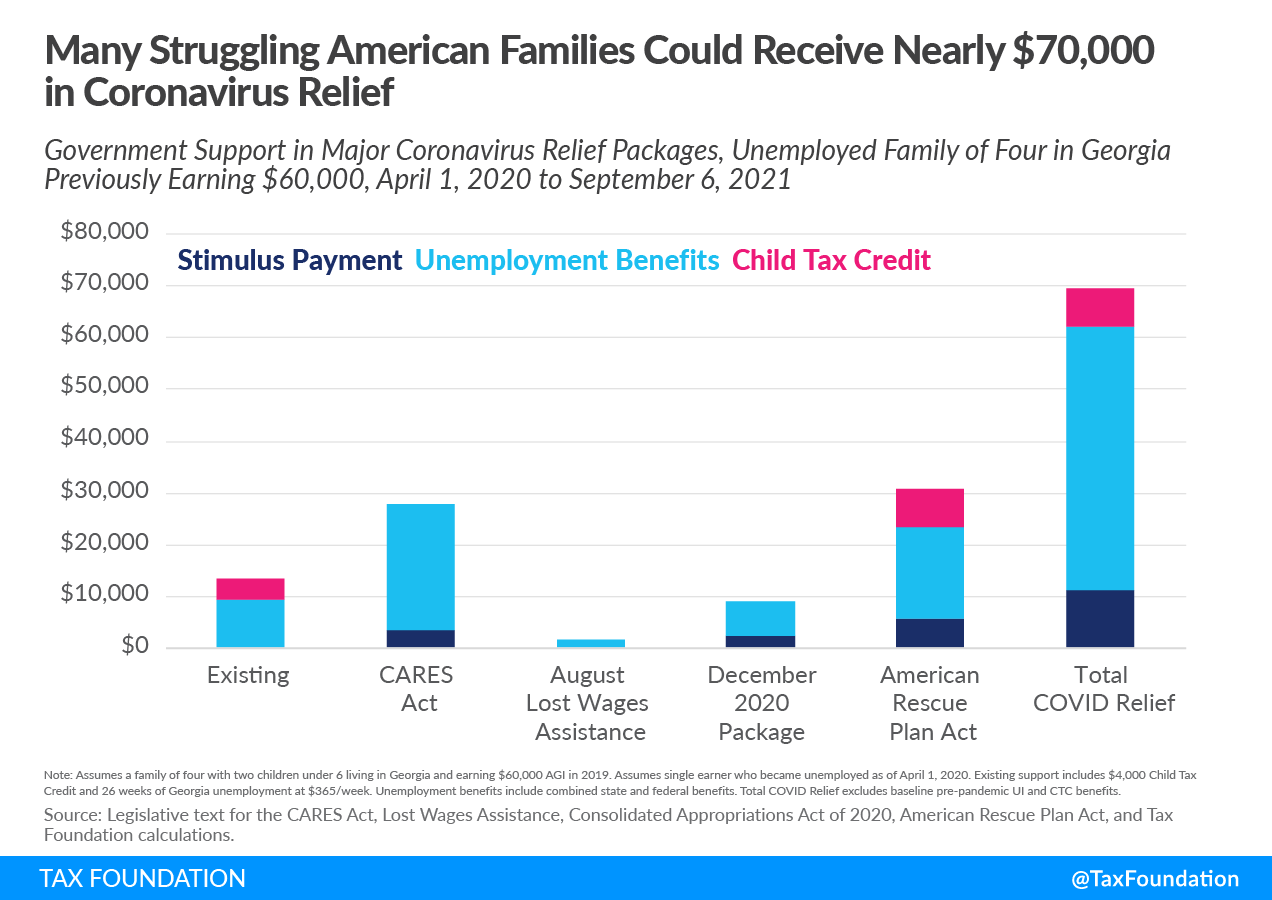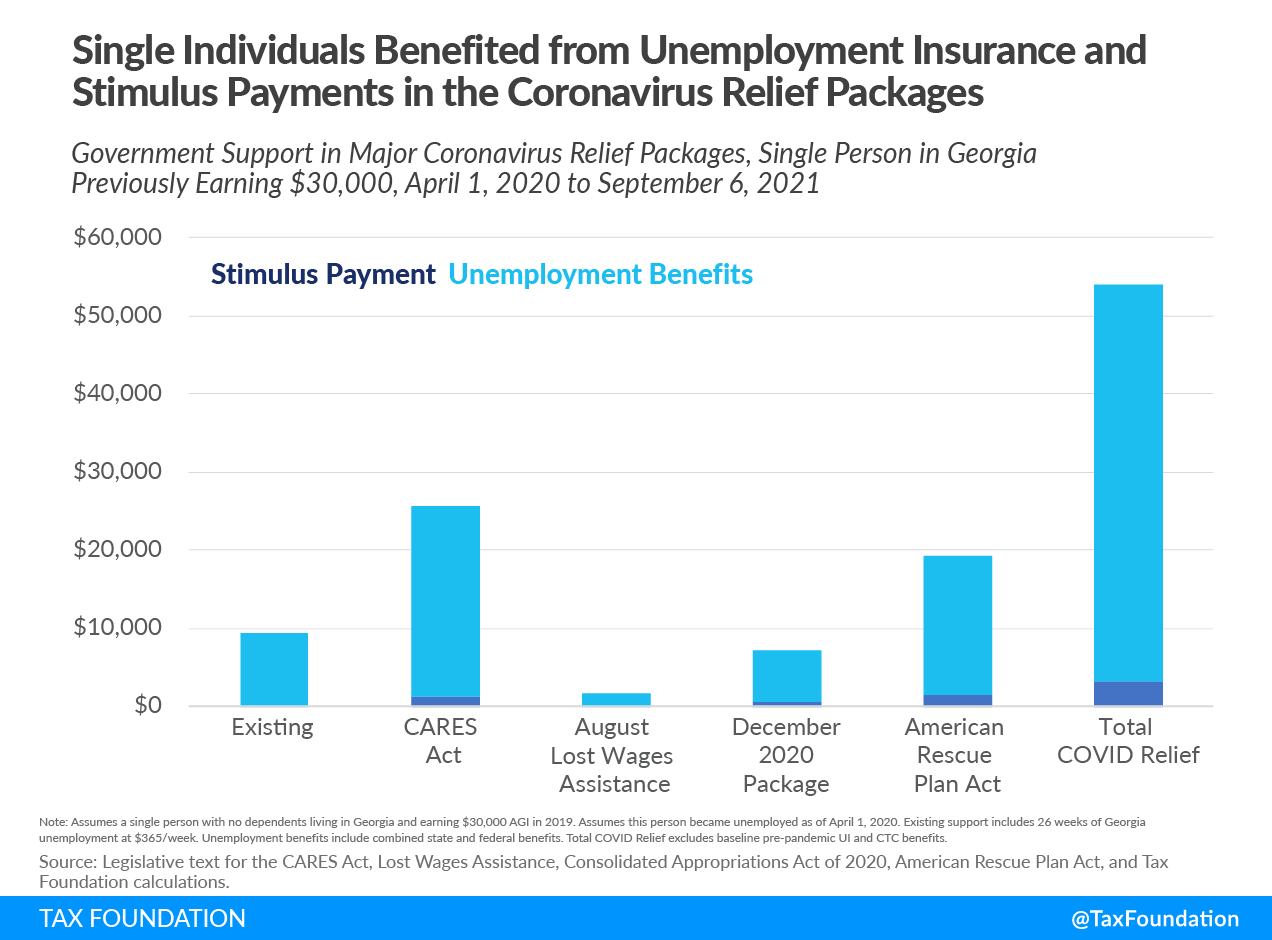With passage of the American Rescue Plan Act (ARPA), much of the $6 trillion in relief over the past year was directed to the unemployed in unemployment insurance (UI) benefits and to low- and moderate-income households in stimulus payments and child tax credits (CTC).
The unemployment insurance benefits paired existing state-level weekly aid with a federal payment ranging from $600/week under the CARES Act to $300 per week under the American Rescue Plan Act. The aid was also extended to workers who usually do not qualify for unemployment benefits, including gig economy workers and independent contractors. Unemployed workers could continue to claim unemployment insurance benefits past the usual 26-week window during the pandemic.
Take, for example, a married household with two young children living in Georgia with a single earner who made $60,000 in 2019. Imagine the single earner lost her job on April 1, 2020 due to the coronavirus pandemic. Prior to the pandemic, the family would have been eligible for $365 per week from the state of Georgia in unemployment benefits up to 26 weeks and $4,000 in Child Tax CreditA tax credit is a provision that reduces a taxpayer’s final tax bill, dollar-for-dollar. A tax credit differs from deductions and exemptions, which reduce taxable income rather than the taxpayer’s tax bill directly. , for a total of $13,490.
During the pandemic, that family will have received $50,840 in federal and state unemployment benefits from April 1, 2020 to September 6, 2021, plus $11,400 in stimulus payments, plus $7,200 in Child TaxA tax is a mandatory payment or charge collected by local, state, and national governments from individuals or businesses to cover the costs of general government services, goods, and activities. Credit, totaling $69,440 in combined COVID-19 relief benefits (see Chart 1).
The unemployment insurance benefits calculated include the combined state and federal benefits provided by the CARES Act; the six weeks of Lost Wages Assistance totaling $300 per week provided by the Federal Emergency Management Association (FEMA) in August 2020; state and federal benefits under the December relief deal; and additional unemployment insurance benefits provided under the American Rescue Plan Act (ARPA), which expires on September 6, 2021 (see Table 1).
| Federal Benefit | State Benefit | Total Benefit | |
|---|---|---|---|
| Unemployment Insurance Benefit Prior to Pandemic | $0 | $365/week for 26 weeks | $9,490 |
| CARES Act | $600/week for 17 weeks (April 5 to July 31, 2020) | $365/week for 39 weeks (April 5 to December 31, 2020) | $24,435 |
| Lost Wages Assistance | $300/week for 6 weeks | N/A | $1,800 |
| December 2020 Relief Package | $300/week for 10 weeks (January 2 to March 14, 2021) | $365/week for 10 weeks (January 2 to March 14, 2021) | $6,650 |
| American Rescue Plan Act | $300/week for 27 weeks (March 14 to September 6, 2021) | $365/week for 27 weeks (March 14 to September 6, 2021) | $17,955 |
| Total (Pandemic Relief) | $23,100 | $27,740 | $50,840 |
|
Source: Tax Foundation calculations based on relief legislation text; Georgia Department of Labor. |
|||
The American Rescue Plan Act provided an expanded Child Tax Credit, which, for this family, would be worth $3,600 for each child or $7,200 total in the 2021 tax year compared to $4,000 provided under current law.
Some households may have received upward of $100,000 in combined benefits in states with more generous base unemployment insurance payments, such as Massachusetts. Single individuals also received generous benefits over the past year—an unemployed single person previously earning $30,000 in Georgia would be eligible for about $54,000 in relief from April 2020 to September 2021 (see Chart 2).
The two examples only examine three major sources of pandemic aid for households. The U.S. relief response went further by providing distressed businesses with forgivable loans to retain workers on payroll and cover fixed expenses, business tax relief for small businesses, and hundreds of billions of dollars in support for state and local governments.
The next task for policymakers is deciding how to phase out pandemic relief when the public health situation hopefully improves later this year and the economy reopens more fully. The American Rescue Plan Act was a big bet that generous support will not slow the labor market recovery by disincentivizing work, and appropriate phaseouts for unemployment insurance must be kept to ensure that effective relief can be balanced with a successful rebound for the American economy.
Related Resources
- COVID-19 Tax Resource Center
- American Rescue Plan: Details and Summary
- American Rescue Plan Act Allocates $2 Billion to Nonexistent County Governments
- Making the Expanded Child Tax Credit Permanent Would Cost Nearly $1.6 Trillion
- Expanding Child Tax Credit as Monthly Payment for Pandemic Relief
- State & Local Aid Allocation in the American Rescue Plan
- Does the American Rescue Plan Ban State Tax Cuts?

